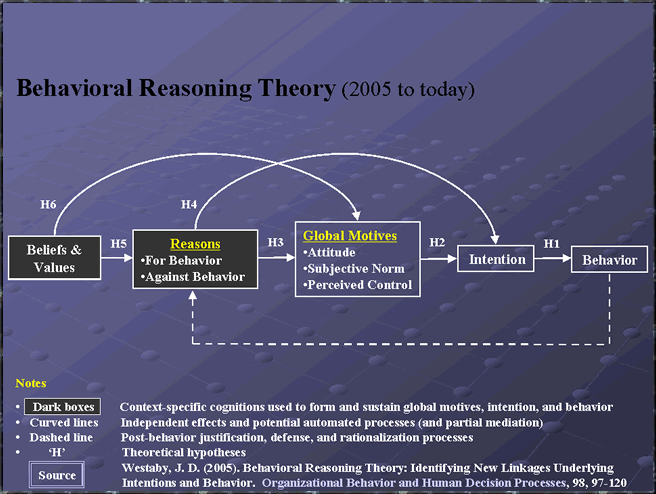Reasoning Underlying the Roles in DNT
Behavioral Reasoning Theory
Decision models and behavioral intention theories, which have vast research, fortunately can serve as further explanatory mechanisms about how people think about engaging in the different social network roles in dynamic network theory. For example, should I support my friend's new idea (S role)? Should I start important parts of a new project on my own (G role)? The theories outlined below can help explain how people engage in the decision and intention formation process for any of the social network roles in dynamic network theory, from a more explicit (than implicit) psychological approach. It also explores why people may engage in a role or combination of multiplex roles in the first place.
Traditional Behavioral Intention Theories
Contemporary behavioral intention theories have greatly advanced our scientific understanding of behavior. These theories rely on the theory of reasoned action (Fishbein & Ajzen, 1975) and the theory of planned behavior (Ajzen, 1991), which are directly connected to our Lab’s lineage and conceptual history. In general, these frameworks propose that intentions are the best predictors of human behavior and that people's attitudes, feelings of social pressure (i.e., subjective norm), and perceived control predict intentions. These theories have received tremendous support in many behavioral domains (Ajzen, 2001; Eagly & Chaiken, 1993; Sheppard, Hartwick, & Warshaw, 1988) and are some of the most widely, if not the most widely applied theories in psychology, based on Web of Science indicators. Although these theories have been critical for understanding behavior, they have not incorporated how people's "reasons" may theoretically impact motivational processes. Thus, Westaby (2005) created behavioral reasoning theory to address the theoretical and empirical importance of utilizing people's own reasons, explanations, and justificaitons in contemporary theories of behavior.
What is Behavioral Reasoning Theory?
Behavioral reasoning theory is a broad theory of behavior that can be used to explain the motives underlying human behaviors. According to this theory, intentions predict behavior, global motives (e.g., attitudes, subjective norms, and perceived control) and reasons predict intentions, and beliefs and values predict reasons. Reasons also become stronger once behavior is executed, often through post-decision dissonance and rationalization processes.

Other Distinguishing Features and Assumptions in Behavioral Reasoning Theory
- Not all beliefs and values become the reasons for your behavior.
- Some reasons can also represent the multiple goals individuals have in their behavioral pursuits.
- People often search for behavioral options in memory that have the most justifiable and defensible set of reasons. When those options are identified, decisions and intentions can be implemented with more confidence.
- Reasons can independently contribute to global motives and intentions in some settings. Thus, context-specific reasons are presumed to be important proximal determinants of human behavior in various contexts.
- The theory assumes that reasons impact global motives and intentions, because they help individuals justify and defend their actions, which promotes and protects their self-worth, for example. Reasons can also "help individuals make sense of their world by providing them with causal explanations for their behavior, the behavior of others, and causal relationships in their environment." (p.100).
- Reasons may be skipped by automated processing (e.g., stimulus response or implicit/sub-conscious factors).
- People often rationalize their behavior after the fact, which can bolster and sustain behavioral commitment.
- Reasons are not sufficient to explain intentions and behavior. People's global motives, such as attitudes, norms, and perceived control, can also have independent effects unaccounted for by reasons. Thus, when a person overtly describes the specific reasons for the behavior," there are likely other factors motivating the person that are beyond the person's awareness.
- The theory does NOT assume that reasons are rational and unbiased. However, they can still be motivational even when inaccurate. For example, a person may decide to gamble, because of the person's reason “I will surely win a lot tonight”, even though objective data suggests that this is not a certainty at all.
- Interventions successfully targeting people's global motives and specific reasons can result in powerful changes in intention and behavior.
Reference for the originating theory paper:
Westaby, J.D. (2005). Behavioral Reasoning Theory: Identifying New Linkages Underlying Intentions and Behavior. Organizational Behavior and Human Decision Processes, 98, 97-120.
Scope
Despite the power of such theorizing above to predict and explain the psychological states underlying specific behaviors, they have difficulty describing, explaining, and visualizing the larger behavior in rich complex human systems. Thus, judgment and decision concepts above are subsumed within components in dynamic network theory, which attempts to explain complex systems in multiple contexts at multiple levels, while remaining connected to underlying psychological models that have strong scientific support.
What's New with BRT in Applied Decision Making?
The Lab's work has taken propositions from behavioral reasoning theory and applied them to help people make important decisions in their lives. Using advanced survey tools and computer programming, Westaby created the Decision Making Calculator. This uses his Pro, Con, and Counterargument approach, grounded in the theory, to also predict decision confidence, satisfaction, and potentially mitigated regret.
Click here to go to the Decision Making Calculator
What's New for Expansions of the Theory?
Recent / upcoming presentations at scientific conferences:
Society for Judgement and Decision Making, New York, Winter 2024
Westaby and Colleagues
Title:
Expanding Behavioral Reasoning Theory (BRT) to Account for Depth-of-Processing Concepts:
Predicting Important Personal Decisions and Subsequent Satisfaction
Short Abstract:
An integrative BRT was tested. Multiple studies indicated that a priori primary pro and con reasoning predicted comparative reasoning (i.e., the perception that one's idiosyncratic pro reasoning is more influential in the decision process than con reasoning). Behavioral reasoning components predicted intentions over past theories. Counter reasoning predicted attitudinal mediators, supporting depth-of-processing components. Further, comparative reasoning interacted with positive intentions to bolster decision satisfaction. System 2 weighted reasoning more strongly predicted intentions than System 1 heuristic reasoning. Adaptive decision models were also integrated to explain decision pathways.
Copyright James D. Westaby (C). All rights reserved.